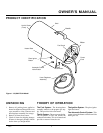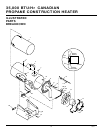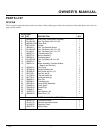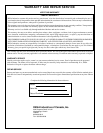
4
103907
35,000 BTU/Hr CANADIAN
PROPANE CONSTRUCTION HEATER
Air For Combustion Air For Heating
Figure 4 - Hose and Inlet Connector
4. Open propane supply valve on propane
tank(s) slowly.
Note:
If not opened
slowly, excess-flow check valve on
propane tank may stop gas flow. If this
happens, close propane supply valve
and open again slowly.
5. Check all connections for leaks. Apply
mixture of liquid soap and water to gas
joints. Bubbles forming show a leak
that must be corrected.
VENTILATION
WARNING: Never use an open
flame to check for a leak. Apply a
mixture of liquid soap and water
to all joints. Bubbles forming
show a leak that must be cor-
rected. Correct all leaks at once.
6. Close propane supply valve.
WARNING: Provide at least a
one square foot (0.09m
2
) opening
of fresh, outside air while run-
ning heater. If proper fresh, out-
side air ventilation is not pro-
vided, carbon monoxide poison-
ing can occur. Provide proper
fresh, outside air ventilation be-
fore running heater.
Figure 3 - Regulator Position
3. Connect hose to inlet connector.
Tighten firmly using a wrench.
IMPORTANT
: Use extra hose or piping if
needed. Install extra hose or piping between
hose/regulator assembly and propane tank.
You must use the regulator supplied with
heater.
WARNING: Review and under-
stand the warnings in the Safety
Information Section, page 2. They
are needed to safely operate this
heater. Follow all local codes
when using this heater.
1. Provide propane supply system (see
Propane Supply).
2. Connect POL fitting on hose/regulator
assembly to propane tank(s). Turn POL
fitting counterclockwise into threads on
tank. Tighten firmly using wrench.
IMPORTANT
: Position regulator so
that hose leaving the regulator is in a
horizontal position (see Figure 3). This
places the regulator vent in the proper
position to protect it from the weather.
WARNING: Test all gas pip-
ing and connections for leaks
after installation or servicing.
Never use an open flame to check
for a leak. Apply a mixture of
liquid soap and water to all joints.
Bubbles forming show a leak.
Correct all leaks at once.
PROPANE SUPPLY
Propane gas and propane tank(s) are to be
furnished by the user.
Use this heater only with a propane vapor
withdrawal supply system. See Chapter 5 of
the Standard for Storage and Handling of
Liquefied Petroleum Gas, ANSI/NFPA 58
and/or CAN/CGA B149.2. Your local li-
brary or fire department will have this book-
let.
The amount of propane gas ready for use
from propane tanks varies. Two factors de-
cide this amount:
1. The amount of propane gas in tank(s)
2. The temperature of tank(s)
This heater is designed to operate with a
minimum 20-pound (9 kg) propane tank.
You may need two or more tanks or one
larger tank in colder weather. Use a 100-
pound (45 kg) tank for longer operation or
in very cold weather. Less gas is vaporized
at lower temperatures. Your local propane
gas dealer will help you select the proper
supply system. The minimum surrounding
air temperature rating for each heater is -
20°F (-29°C).
Average Temp.°F (°C) No. Of Tanks
At Tank Location (100lb/45kg)
40 (4.4) 1
32 (0) 1
20 (6.7) 1
10 (-12) 1
0 (-18) 1
-10 (-23) 2
-20 (-29) 2
Figure 2 - Cross Section Operational View
INSTALLATION
Air for Heating
Combustion Chamber
Clean
Heated Air
Out (Front)
Hose/Regulator
Assembly
Cool Air In
(Back)
Motor
Fan
Air for Combustion
Hose
Inlet Connector
Propane
Tank
Propane
Supply
Valve
Regulator
Hose
POL


















